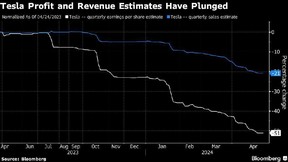Investors worry Elon Musk will pull ‘investment thesis pivot’ and nix cheaper model

Article content
Elon Musk is known to challenge the status quo — and that’s exactly what Tesla Inc.’s investors are worried about right now.
The company’s shares are weathering the longest rout since late 2022, tumbling nearly 19 per cent over the past seven days, amid doubts about its business strategy as sales of electric vehicles slump.
Article content

The latest worry? That Musk, Tesla’s chief executive officer, will announce plans on Tuesday’s earnings call to nix the rollout of a cheaper model and focus on developing a fully self-driving vehicle — a project that would face considerable regulatory and commercial obstacles.
Advertisement 2
Article content
That would mark a major break with what analysts had been expecting and leave the company with no near-term catalyst for growth, just when it’s expected to report the first quarterly sales drop since the pandemic struck in 2020.
“Up until several weeks ago, the key focal point into the first-quarter result was Tesla’s vehicle sales fundamentals, with Tesla facing an extremely challenged set-up amid a sharp delivery miss, risk of no growth in volume in 2024, and further pressure to margins,” said Barclays Plc analyst Dan Levy, who has the equivalent of a neutral rating on the stock.
Article content
Levy said those issues have since taken a back seat to a bigger issue: “An investment thesis pivot.”
Such concerns have driven the stock down nearly 43 per cent this year through Monday’s close to US$142.05, a 15-month low. It’s the second-worst performer in the S&P 500 so far this year, lagging only Globe Life Inc., an insurance company targeted by short sellers. On Tuesday, the shares were down 0.5 per cent at 9:41 a.m. in New York.
This year’s slide in the stock has raised the risk that any disappointment in Tuesday’s earnings report or Musk’s conference call could snowball, according to technical analysts who analyze moves in share prices to predict their future path. To them, the drop below US$150 has already breached a key support level.
Article content
Advertisement 3
Article content
“The stock is now in no man’s land, with a massive air pocket between here and under US$100,” said Todd Sohn, ETF and technical strategist at Strategas Securities.
Musk has already said that the company will be unveiling its so-called Robotaxi in August but hasn’t clarified the plans for the cheaper vehicle. It is possible that Tesla is only going to delay the production of the less-expensive car, rather than shelve it outright.
But the concerns about Tesla’s strategy are exacerbating investors’ nervousness at a time when the company is already contending with slowing growth, thinning margins and sales. Vehicle deliveries for the first quarter, which were announced early this month, lagged analysts’ forecasts by the most in at least seven years.
Over the past 12 months, expectations for first-quarter earnings have been dialled back to 52 cents a share, half of what was once anticipated. The revenue forecast — now about US$22.3 billion — has been cut 22 per cent over that time, according to data compiled by Bloomberg, while estimated free cash flow slid 70 per cent to around US$654 million.
Advertisement 4
Article content
That’s why Tesla’s stock-price still looks high, by some measures, despite the recent drop: At nearly 47 times forward earnings, it’s significantly more expensive than every other member of the so-called Magnificent Seven tech stocks.
On the flip side, the negative sentiment has set a relatively low bar, creating the potential for a relief rebound.
“The news flow and psychology surrounding Tesla have become so negative that a modest miss may already be getting priced in,” said Steve Sosnick, chief strategist at Interactive Brokers LLC.
But that hasn’t tended to be the case. Tesla shares dropped at least 9 per cent the day after the past four quarterly reports, and options trading implies expectations of an 8 per cent move in either direction following Tuesday’s numbers.
Recommended from Editorial
-

Tesla’s ‘gravity-defying’ powers at risk as EV market slows
-

Tesla sales fall short by biggest miss ever in brutal blow for EVs
-

Tesla collapse has investors wondering if it’s still magnificent
Demand for short-term puts paying off on a 10 per cent slide has jumped to its highest premium over equivalent calls since November. All told, that signals that investors are paying more for protection in case the stock slips, as opposed to options that position for gains.
“The earnings are so crucial,” said Sosnick. “If we get a profound disappointment, then US$100 is a likely next stop.”
Bloomberg.com
Article content
Source link




